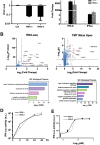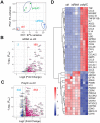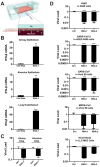This is a preprint.
Self-assembling short immunostimulatory duplex RNAs with broad spectrum antiviral activity
- PMID: 34845453
- PMCID: PMC8629196
- DOI: 10.1101/2021.11.19.469183
Self-assembling short immunostimulatory duplex RNAs with broad spectrum antiviral activity
Update in
-
Self-assembling short immunostimulatory duplex RNAs with broad-spectrum antiviral activity.Mol Ther Nucleic Acids. 2022 Sep 13;29:923-940. doi: 10.1016/j.omtn.2022.08.031. Epub 2022 Aug 24. Mol Ther Nucleic Acids. 2022. PMID: 36032397 Free PMC article.
Abstract
The current COVID-19 pandemic highlights the need for broad-spectrum antiviral therapeutics. Here we describe a new class of self-assembling immunostimulatory short duplex RNAs that potently induce production of type I and type III interferon (IFN-I and IFN-III), in a wide range of human cell types. These RNAs require a minimum of 20 base pairs, lack any sequence or structural characteristics of known immunostimulatory RNAs, and instead require a unique conserved sequence motif (sense strand: 5'-C, antisense strand: 3'-GGG) that mediates end-to-end dimer self-assembly of these RNAs by Hoogsteen G-G base-pairing. The presence of terminal hydroxyl or monophosphate groups, blunt or overhanging ends, or terminal RNA or DNA bases did not affect their ability to induce IFN. Unlike previously described immunostimulatory siRNAs, their activity is independent of TLR7/8, but requires the RIG-I/IRF3 pathway that induces a more restricted antiviral response with a lower proinflammatory signature compared with poly(I:C). Immune stimulation mediated by these duplex RNAs results in broad spectrum inhibition of infections by many respiratory viruses with pandemic potential, including SARS-CoV-2, SARS-CoV, MERS-CoV, and influenza A, as well as the common cold virus HCoV-NL63 in both cell lines and human Lung Chips that mimic organ-level lung pathophysiology. These short dsRNAs can be manufactured easily, and thus potentially could be harnessed to produce broad-spectrum antiviral therapeutics at low cost.
Conflict of interest statement
Conflict of Interest
D.E.I. is a founder, board member, SAB chair, and equity holder in Emulate Inc. D.E.I., L. S., H. B., C.O., and R.P. are inventors on relevant patent applications held by Harvard University.
Figures






References
-
- Kato H., Takeuchi O., Mikamo-Satoh E., Hirai R., Kawai T., Matsushita K., Hiiragi A., Dermody T.S., Fujita T. and Akira S. (2008) Length-dependent recognition of double-stranded ribonucleic acids by retinoic acid-inducible gene-I and melanoma differentiation-associated gene 5. J Exp Med, 205, 1601–1610. - PMC - PubMed
-
- Ren X., Linehan M.M., Iwasaki A. and Pyle A.M. (2019) RIG-I Selectively Discriminates against 5’-Monophosphate RNA. Cell Rep, 26, 2019–2027 e2014. - PubMed
-
- Ren X., Linehan M.M., Iwasaki A. and Pyle A.M. (2019) RIG-I Recognition of RNA Targets: The Influence of Terminal Base Pair Sequence and Overhangs on Affinity and Signaling. Cell Rep, 29, 3807–3815 e3803. - PubMed
Publication types
Grants and funding
LinkOut - more resources
Full Text Sources
Other Literature Sources
Molecular Biology Databases
Miscellaneous
